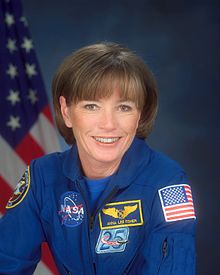Anna Fisher | |
|---|---|
 Fisher in 2002 | |
| Born | Anna Lee Tingle August 24, 1949 Albany, New York, U.S. |
| Education | University of California, Los Angeles (BS, MD, MS) |
| Spouse | [1] |
| Children | 2, including Kristin |
| Awards |
|
| Space career | |
| NASA astronaut | |
Time in space | 7d 23h 45m |
| Selection | NASA Group 8 (1978) |
| Missions | STS-51-A |
Mission insignia | |
Anna Lee Fisher (née Tingle; born August 24, 1949) is an American chemist, emergency physician and a former NASA astronaut. Formerly married to fellow astronaut Bill Fisher, and the mother of two children, in 1984, she became the first mother to fly in space. During her career at NASA, she was involved with three major programs: the Space Shuttle, the International Space Station and the Orion spacecraft.
A graduate of University of California, Los Angeles (UCLA), where she earned a Bachelor of Science degree in chemistry in 1971, Fisher started graduate school in chemistry, conducting X-ray crystallographic studies of metallocarboranes. The following year she moved to the UCLA School of Medicine, where she received her Doctor of Medicine degree in 1976. She completed her internship at Harbor General Hospital in Torrance, California, in 1977, and chose to specialize in emergency medicine.
Fisher was selected as an astronaut candidate with NASA Astronaut Group 8, the first group of NASA astronauts to include women, in January 1978. She became the Astronaut Office representative for the development and testing of the Canadarm remote manipulator system and the testing of payload bay door contingency spacewalk procedures. For the first four Space Shuttle missions she was assigned to the search and rescue helicopters supporting the flights. For the next four missions, she was involved in the verification of flight software at the Shuttle Avionics Integration Laboratory (SAIL), and was a "Cape Crusader"—one of the astronauts who supported vehicle integration and payload testing at Kennedy Space Center. She flew in space on the Space Shuttle Discovery on the STS-51-A mission in November 1984, during which she used the Canadarm to retrieve two satellites that had been placed in incorrect orbits.
After a leave of absence to raise her family from 1989 to 1995, Fisher returned to the Astronaut Office, where she worked on procedures and training issues in support of the International Space Station (ISS). She was a capsule communicator (CAPCOM) from January 2011 to August 2013, and the lead CAPCOM for ISS Expedition 33. She was involved in the development of the display for the Orion spacecraft until her retirement from NASA in April 2017.
- ^ Burgess, Colin; Shayler, David J. (2020). NASA's First Space Shuttle Astronaut Selection: Redefining the Right Stuff. Sprigner Praxis. pp. 478–479. ISBN 978-3030-45741-9. OCLC 1145568343.